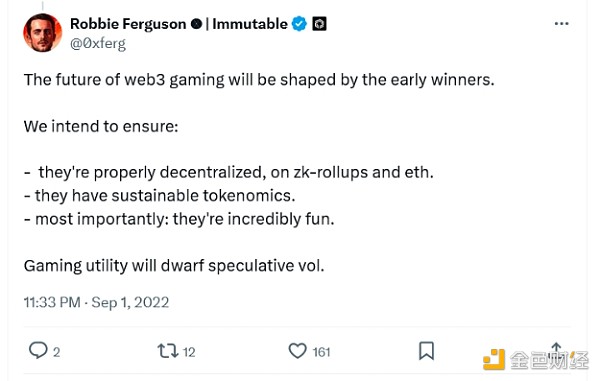Author: Brayden Lindrea, CoinTelegraph; Compiler: Baishui, Golden Finance
Industry executives say that despite the continued resistance of some gamers to "token economics," game studios are likely to continue using airdrops and other incentives to attract players.
"It's a very easy way to gain market share," Kieran Warwick, founder of game studio Illuvium, said in an interview.
However, Warwick said that games that fail to provide fun are still doomed to fail.
"The problem is that if you use it as a marketing tool and don't have a good product to support it, your retention rate will be terrible."
Shi Khai Wei, founder of venture capital firm LongHash Ventures, also emphasized the importance of making games fun.
“Crypto is very good at acquiring users because of the incentives — we have airdrops, earning money by playing games, and speculative elements, but to retain players you need more interesting gameplay.”
Axie Infinity is one of the biggest success stories in blockchain gaming to date. However, events such as the $650 million hack made it difficult for its creator, Sky Mavis, to retain users after the last bear market.
He said: "The games that can achieve sustainable economic development, have the right release schedule, attract the right players, and incentivize the right gameplay will survive."

Source: Robbie Ferguson
Not everyone wants to make money
Warwick admitted that Token incentives will inevitably attract airdrop players rather than actual gamers, but that’s a necessary evil to grow the player base.
“It also gets us the attention we need from players in the space,” he added.
His comments come as Illuvium last week issued 200,000 ILV tokens, worth about $25 million, for its six-month Play-to-Airdrop program.
The airdrops, which will be collected across Illuvium Arena, Overworld, Zero and Beyond, will launch on IMX, Ethereum’s Layer 2 NFT platform, in late May.
Meanwhile, Gabby Dizon, CEO of Yield Guild Games, believes that while airdrops can play an important role in accelerating GameFi adoption, “not everyone is necessarily looking for a financial reward.”
“You might buy an asset that gives you social status, just like you might buy an expensive car, watch or piece of clothing.”
GameFi standards still have a long way to go
Dizon and Warwick believe that GameFi is still about 14-15 years behind traditional gaming, but they expect that gap to close soon.
Warwick noted that “the pace of innovation in blockchain is much faster than in the traditional gaming space,” as many of the people in blockchain studios come from mainstream studios that have developed games that have “millions of players.”
“So we’re not starting from scratch, but at the same time, we’re building IP, and that’s the thing that takes the most time — like getting people to fall in love with the storyline, the universe you’re in, the creation, and how the characters interact with each other.”
“All of these elements can’t be created overnight,” he added.
Warwick noted that building IP can take up to six to seven years, adding that leading game studios are about halfway through the process.
Until then, we’re still waiting for the dominance of GameFi projects to drive the industry forward, just as traditional games like Clash of Clans and Candy Crush Saga did in the early 2010s, Dixon said.
Still, Wei is confident that the GameFi industry will eventually release AAA-standard games by 2024.
 Bitcoinist
Bitcoinist
 Bitcoinist
Bitcoinist Coinlive
Coinlive  Others
Others Tristan
Tristan Coinlive
Coinlive  Beincrypto
Beincrypto Coindesk
Coindesk Nulltx
Nulltx Cointelegraph
Cointelegraph Cointelegraph
Cointelegraph